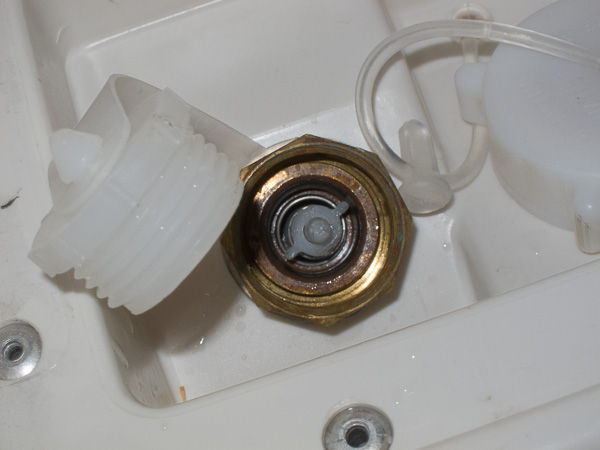In a couple months I'll need to winterize my travel trailer. When I bought t last winter it was already done and done with RV antifreeze. I was thinking about using the compressed air to blow out the lines method. It seems cleaner to me and the tools to do it cost less than the antifreeze (although the tools and the antifreeze are really cheap).
Does anyone have suggestions or pros and cons of one method versus the other?
thanks
The air fitting you use to blow out the lines is fine, but it doesn't allow for enough flow to be certain you're getting all the water. If you have a little belly in a line, it might push enough water through just to let the air bypass it without fully blowing it out.
I'm sure you found the line drains and tank drain. Even if you didn't fill the tank, the one-way valve near the pump can leak allowing city water pressure to backfill the tank a bit.
I use air to blow out the lines just to get the bulk of the water out. The main reason I do this is so I'm not mixing anti freeze with a line full of water. This way, you get pink at the faucets first instead of a bunch of water and "is that pink yet? not sure, keep pumping." It minimizes antifreeze waste.
I open all drains and faucets (don't forget the loo), then blow out with water. Don't forget to empty the water heater, THEN bypass. If you do it the other way around you can have water trapped between the bypass valve and the heater.
So you do both? That does make sense.
speaking of the check valve. Last time I camped I noticed when the pump was running it would push water out the city fill. I had a shut off valve so I put it on the city water and closed it, that worked. I guess I need to pull apart the cover over the pump, which means I have o take out the couch to get to thag area.
Here in Seattle we don't really get hard freezes, so I've never done the antifreeze method and have not had any issues. If I lived somewhere that got *really* cold I'd do the AF, no question. RV plumbing can be an expensive PITA to deal with, so why take the risk.
Even if you don't do AF, you should flush and sanitize the fresh water system in the spring before use anyway.
Oh yeah, and good point by Curtis on the WH. It's also a good opportunity to check the anode and replace if necessary.
Thanks for the feedback. I'll do both. I empty the WH and then bypass whenever I get back from a trip. I sanitized it when I started his year and half way through the year. I didn't want to take any chances on that deal!
In reply to New York Nick :
Depends on the setup, but most modern RV plumbing is a bit simpler. The one-way valve that prevents the tank from filling on city water is usually in the pump. The one way valve that does the opposite is right there at the city water hookup. Inside behind the screen filter you'll see either a brass ball or a plastic plunger. Often times the o-ring in that check valve fails allowing it to leak water out from pump pressure.
Usually you look in and see something like this:

That plastic piece when you take it out looks something like this:

And yes, I do both. In fairness, I leave the RV in Ontario so I have to be pretty darn certain.
Some RVs claim that they have a true downhill piping and they don't have bellies in the hoses that can hold water, but I don't trust em. I've also had one freeze and burst. Totally my fault. I rushed the winterization because I was on my way to Florida in a couple weeks. When I got there and hooked up the water, I flooded the storage under the bed.
It's not so much that taking the extra step isn't a pain in the butt, it's the plumbing repair while squeezing my fat ass in the storage door to repair some plumbing was a lot more of a pain in the butt.
Fwiw we're on the gulf coast & the motorhome we bought a few weeks ago was winterized with pink antifreeze, so I'm planning on using it when I winterize it too.
Thanks. I appreciate the input. I'll buy the compressed air fittings today so I have them and I'll be ready. I'll try to evaluate check valves but it's a little far down the broken stuff I have to fix list for today (paint door, fix leaf vacuum, new carb on Wheel Horse, install number on Trackster then I can get to camper), that may linger a couple weeks.
Once you get the air fittings for the city water, you can use it as a secondary check valve. Just leave it screwed on the city water inlet and the schrader valve will be your check valve.





















